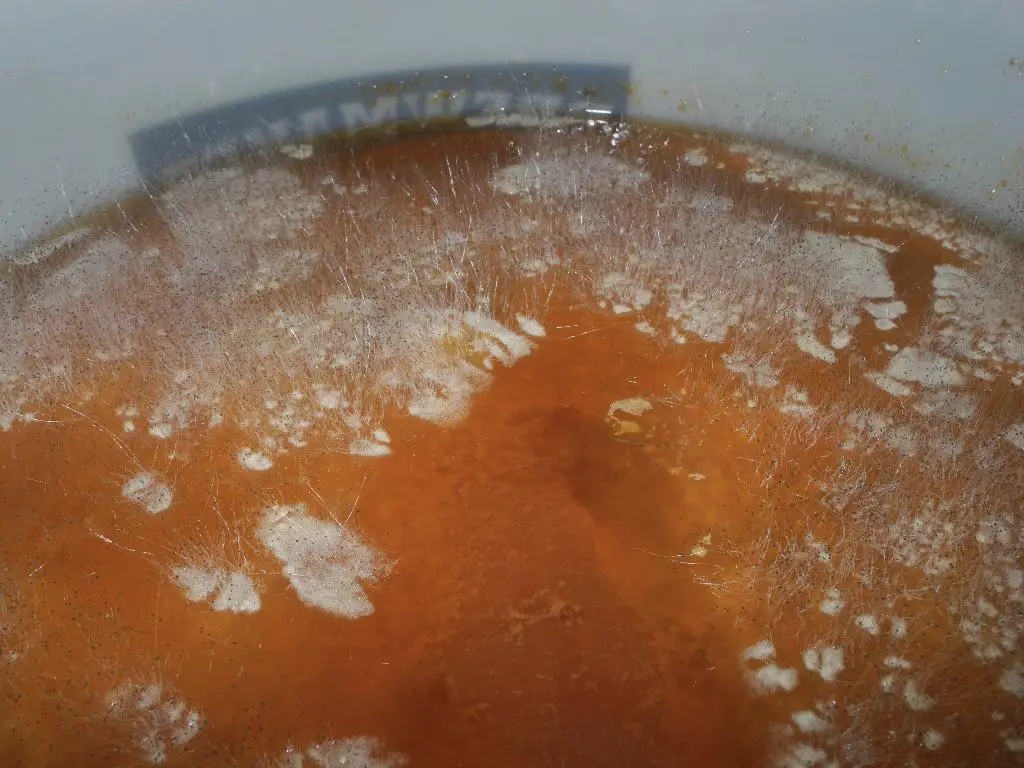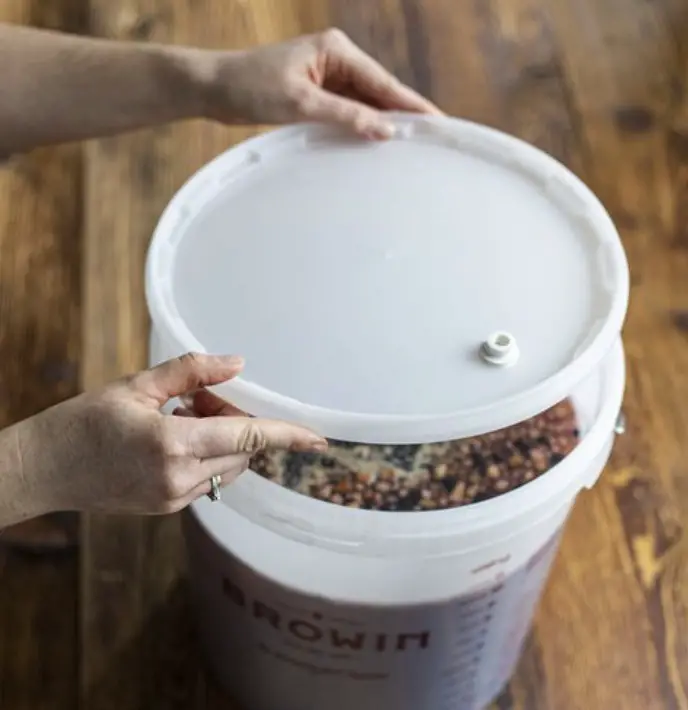Fermentation typically occurs in an anaerobic environment, meaning without air. This makes the formation of ethanol much more efficient.
However, some forms of brewing, such as those that occur in open crocks or barrels, can allow for limited exposure to air.
This is because, as explained in a previous article, that during active fermentation, the CO2 will create an excess pressure inside the vessel that pushes out any oxygen before it has a chance to enter!
So a fermentation vessel does not have to be completely airthight as long as active fermentation is taking place.
The key is to limit the amount of oxygen present to prevent the growth of unwanted microorganisms.
The container used for fermentation should be sealed as much as possible to prevent the entry of air, but should also allow for the release of gases produced during fermentation.
Can you open the lid during fermentation?
It is generally not recommended to open the lid during wine or cider fermentation. Allowing oxygen to enter will slow down the fermentation process and increase the risk of contamination.

Additionally, opening the lid can also introduce unwanted bacteria or wild yeast into the fermenter, which can also spoil the final product. It is best to leave the lid sealed and monitor the fermentation process through the airlock only until ready for bottling.
However, in the beginning of the brewing process, where the yeast has still not grown to its full biomass, there can be a benefit of letting in some oxygen to encourage more efficient yeast growth.
This is usually done in the beginning before making the container airtight.
After the fermentation vessel has been airtight, and ethanol has formed, there is a risk of ethanol oxidation and growth of unwanted bacteria if oxygen is let in again.
During active fermentation, when bubbles appear vigorously in the airlock, it is not such as big deal to open the lid as the large amounts of CO2 produced at this stage will quickly displace the oxygen that have entered.
Therefore it is recommend minimizing the times the lid is removed at the end stages of fermentation.
Do you need an airlock for fermentation of cider?
Yes, an airlock is necessary for fermentation of cider. Airlocks are used to allow carbon dioxide produced during fermentation to escape without allowing oxygen or other contaminants into the fermenter.
However, there are many ways to make an airlock and it does not have to be the traditional S-shaped plastic tube you might be used to.

An airlock can simply be a tube with one end through an airtight lid in your fermenter and the other end into a bucket or glass of water!
A semi-tight lid can also be a type of airlock as pressure will build up and escape, but air will not be let in.
In fact, this is how I made my first cider. Simply by leaving a rubber ring under a loosely screwed on lid! No fancy equipment needed for that…
Can you remove airlock during fermentation?
It is not recommended to remove the airlock during fermentation, but again, if it is done for a short time period during active fermentation, it might not be a big problem.
The airlock serves as a barrier to prevent oxygen from entering the fermenter while allowing the carbon dioxide produced during fermentation to escape.
Removing the airlock can allow oxygen to enter the fermenter, which can disrupt the fermentation process and potentially spoil the wine or cider.
Additionally, it may also introduce unwanted bacteria or wild yeast into the fermenter. It is best to leave the airlock in place and monitor the fermentation process through it.
Can you ferment in a completely closed container?
Yes, but it can be quite dangerous! Whereas secondary fermentation (bottle carbonation) is performed in closed containers, you should never perform primary fermentation in a closed container.

Fermentation forms CO2 and although much less than that of respiration, it is definitely enough to create a high pressure that will lead to rupture of even the sturdiest of fermentation containers!
For secondary fermentation, it is only safe because you have calculated exactly how much priming sugar to add so that you get the perfect CO2 formation and no more than that!
Can oxygen ruin beer or cider fermentation?
Oxygen mostly just allows the yeast to “cheat” us by not producing the alcohol we want in our fermentation, but it can also lead to unwanted oxidation and growth of spoilage bacteria and mold.
Oxygen can ruin fermentation by promoting the growth of unwanted microorganisms, such as aerobic bacteria, unwanted yeasts and mold/mildew because many can only really grow with oxygen or are able to outcompete the brewing yeast in the presence of alcohol.
Mold (filamentous fungi) is an example of organisms that grows only in the presence of oxygen and will therefore typically appear on the surface of a liquid fermentation.
Therefore, the presence of mold patches on top of your cider/wine/beer is a sign that too much oxygen has been let in!

These organisms can produce off-flavors, spoil the fermented product, and prevent the desired microorganisms from carrying out the fermentation process.
Worst case, they can be directly dangerous by producing toxins (some molds and bacteria do!).
- Oxidative spoilage: Oxygen can cause the wine or cider to become stale and lose its freshness and aroma by reacting with some of the flavourful compounds in the brew.
- Growth of unwanted microorganisms: Many bacteria require oxygen to survive (well) and all molds will only grow when oxygen is present. Oxygen also encourage the
Therefore, you might risk pushing your fermentation off-track by letting in oxygen or even ruining it completely. - Formation of acetic acid: Oxygen can cause the growth of acetic acid bacteria, which can lead to the formation of acetic acid and spoil the wine or cider. Prolonged oxygen exposure can also lead to direct oxidation of alcohol into acetic acid.
- Formation of other acids: Oxidation of brewing metabolites can also cause the formation of other volatile acids, which can lead to off-flavors and aromas in the wine or cider.
- Interference with the yeast metabolism: Oxygen can cause the yeast to produce unwanted by-products such as diacetyl, which can lead to off-flavors and aromas in the wine or cider.
- Premature aging: Oxygen can cause the wine or cider to age faster than desired, resulting in a loss of complexity and flavor.
Oxidation can affect the taste of cider due to the presence of oxygen. This can cause the cider to taste sour or bitter, and in some cases, like wet cardboard. Oxygen can enter the cider during bottling, depending on the technique used, which can cause oxidation flavors to develop.
Oxygen can also cause the cider to age more quickly than intended, which can result in a sour taste. In order to avoid this, it is important to use an appropriate bottling technique, such as a bottle filler, to minimize the amount of oxygen that can enter the cider.
To avoid this, the goal is to maintain an anaerobic environment during fermentation and limit the exposure of the fermented product to air.
However, some fermentation processes like wild fermentation, kombucha and sourdough bread making, require (limited) exposure to air.
The microorganisms that are used in these fermentations are able to ferment the sugars even in the presence of oxygen, but create mostly acids instead of alcohol as a by-product.
What does oxidized cider taste like?
Oxidized cider will often have a sour taste, similar to wet cardboard. It can have a distinct metallic flavor, with notes of sherry or vinegar.
It may also have a hint of caramel or port-like sweetness. The longer the cider is aged, the more intense the oxidized flavors will become.
Does oxygen kill yeast?
No, oxygen does not directly kill yeast. In fact, yeast requires oxygen to grow and reproduce. Oxygen is essential for the aerobic respiration of yeast, which is a process that allows the yeast to generate energy from glucose and other sugars.
Without oxygen, yeast can still produce energy, but through a less efficient process known as anaerobic respiration, which produces ethanol and carbon dioxide as byproducts.
However, exposure to too much oxygen can have negative effects on yeast, such as producing reactive oxygen species that can damage the yeast’s cellular components and reduce its ability to grow and ferment.
Additionally, oxygen can also promote the growth of other microorganisms, such as bacteria, which can compete with yeast for resources and cause spoilage of the fermentation process.
In summary, while yeast requires oxygen for growth, too much oxygen can be harmful and can negatively affect the fermentation process.
Conclusion
In conclusion, the role of oxygen in fermentation is a delicate balance that significantly impacts the outcome of the brewing process. While some exposure to air is permissible during the initial stages of fermentation to encourage efficient yeast growth, it becomes crucial to minimize oxygen contact as the process progresses.
Maintaining an anaerobic environment is essential to prevent the growth of unwanted microorganisms, spoilage, and the production of off-flavors. The use of airlocks in fermentation vessels serves as a protective barrier, allowing the release of gases while preventing the entry of oxygen and contaminants.
The risks associated with opening the lid or removing the airlock during fermentation highlight the importance of vigilance in the brewing process. Oxygen can lead to oxidative spoilage, unwanted microbial growth, the formation of acids, interference with yeast metabolism, and premature aging. These factors can collectively contribute to off-flavors and aromas, potentially ruining the desired characteristics of the final product.
While some fermentation processes, such as wild fermentation, kombucha, and sourdough bread making, may necessitate limited exposure to air, it is crucial to understand the specific requirements of each fermentation type.
In the world of brewing, airtight does not equate to oxygen-free, and caution must be exercised to avoid dangerous pressure buildup in closed containers. The taste of oxidized cider, often characterized by a sour and metallic flavor, serves as a reminder of the detrimental effects of oxygen on the final product.
In essence, understanding and controlling the oxygen levels throughout the fermentation journey is paramount to achieving the desired flavor profile, quality, and safety of the brewed beverage. As brewers, embracing this knowledge ensures a successful and enjoyable fermentation process, leading to a satisfying end product.





Leave a Reply
You must be logged in to post a comment.